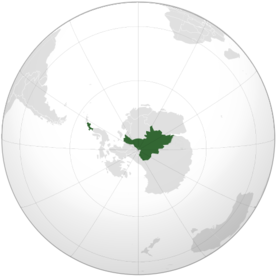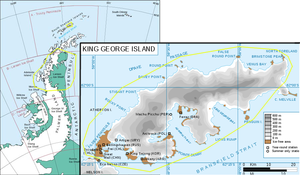Republic of Adelaide
This article refers to a nation which is currently in a state of inactivity. You can help make the article reflect that or ask on the talk page for further information. |
Republic of Adelaide | |
|---|---|
| Motto: Filii Tenebrarum (traditional) Adelaide Terra Incognita (official) | |
| Anthem: Hosana Meus | |
 | |
| Capital | Adelaide Island |
| Largest city | Villa Las Estrellas |
| Official languages | English, German |
| Demonym(s) | Adelaidian; Antarctican |
| Government | Parliamentary Republic |
• Grand Chancellor | Seth Vanderfield |
• Prime Minister | Joan Alessi |
| Legislature | Adelaidian Parliament |
| Establishment | 10 June 2013 |
| Population | |
• Census | 45 |
| Currency | Antarctic Dollar Adelaidian Shilling (proposed) |
| Time zone | (UTC -4), (UTC -3), (UTC +0), (UTC +6), (UTC +7) |
Adelaide, officially the Republic of Adelaide (also known as the Central Antarctic Republic), was an Antarctic micronation located in Antarctic peninsula and in East Antarctica. It was constituted by two regions, which are not connected together. Adelaide is a project born in the summer of 2013, which aims to achieve the claimed territories and to have recognition of sovereignty.
On 1 January 2015, Adelaide merged into the Central Antarctic Republic Confederation.
History
The micronation has been founded by a group of friends in the summer of 2013. The project has then been expanded to several people from different countries. The goal is to be able to visit and get to the territory claimed. For this reason, the members came together in an association that puts in place a number of initiatives to raise funds. The Republic claimed, originally, the territory in the Graham Land. It was later expanded in the continental areas of eastern Antarctica, the polar plateau and a part of Ellsworth land.
Founding the Central Antarctic Republic
In January 2015, Adelaide was founded, together with New South Greenland and Bunger the Central Antarctic Republic.
Geography
The national territory was composed of two regions distant from each other: the Graham Land region and the South Pole Plateau region.
Graham Land

Graham Land is that portion of the Antarctic Peninsula that lies north of a line joining Cape Jeremy and Cape Agassiz. This description of Graham Land is consistent with the 1964 agreement between the British Antarctic Place-names Committee and the US Advisory Committee on Antarctic Names, in which the name "Antarctic Peninsula" was approved for the major peninsula of Antarctica, and the names Graham Land and Palmer Land for the northern and southern portions, respectively.
East Antarctica and Wilkes Land
The area near the pole sits atop a featureless, barren, windswept, icy plateau at an altitude of 2,835 meters (9,301 ft.) above sea level, and located about 1,300 km (800 mi) from the nearest open sea at the Bay of Whales. The ice is estimated to be about 2,700 meters (9,000 ft.) thick at the Pole, so the land surface under the ice sheet is actually near sea level.
Government
The nation is a parliamentary republic. There is a Grand Chancellor, who acts as the head of state and a prime minister, who acts as the head of government. The Prime Minister is elected directly by the people and appoints the government. The Chancellor is elected by the assembly of the regional representatives. There is a parliament composed of 20 members representing the various regions of the nation.

